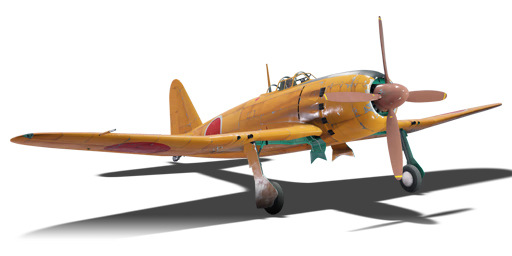




The A7M1 (NK9H), designated as 17-Shi, Reppū (十七試, 烈風), was a pre-production model of the Reppū, the A6M Zero successor. It was developed since late 1940, but faced many delays due to the Navy's high expectations and the lack of powerful engines. Mitsubishi tried to make their own engine, the Ha-43 (MK9), but it was not ready until 1944. The Navy asked Mitsubishi to use Nakajima's Ha-45 Homare (NK9) engine in 1943 instead, but this also took time because of Mitsubishi's prioritization to existing production lines. The A7M1 finally flew in May 1944, and showed great handling and maneuverability, but it was still underpowered with the 2,000 hp engine. The Navy cancelled the order for the Reppū. (Mitsubishi continued development for the MK9 engine for the A7M2, which achieved 2,200 hp and navy approval.)
It was introduced in Update 1.53 "Firestorm". The A7M1 Reppu is the prototype version of the A7M2 in the tech tree fitted with a NK9H engine. In game this fighter is the definition of a "jack of all trades." It has excellent energy retention, amazing turn rate, and decent speed. These traits makes the A7M1 an excellent hybrid between a turn fighter and energy fighter. It can fit almost any playstyle because of it.
flaps
flaps
flaps
brake
| Belt | Belt filling | Armor penetration (mm) at a distance: | |||||
|---|---|---|---|---|---|---|---|
| 10 m | 100 m | 500 m | 1000 m | 1500 m | 2000 m | ||
| T/FI/FI/APHE | 26 | 24 | 17 | 10 | 6 | 4 | |
| HEF-T/HEF/HEF/APHE | 26 | 24 | 17 | 10 | 6 | 4 | |
| APHE/APHE/APHE/APHE/HEF/HEF-T | 26 | 24 | 17 | 10 | 6 | 4 | |
| HEF-T | 4 | 4 | 3 | 3 | 3 | 3 | |
| HEF/HEF/HEF/APHE/APHE | 26 | 24 | 17 | 10 | 6 | 4 | |
| Belt | Belt filling | Armor penetration (mm) at a distance: | |||||
|---|---|---|---|---|---|---|---|
| 10 m | 100 m | 500 m | 1000 m | 1500 m | 2000 m | ||
| T/AP/AP/IAI | 28 | 26 | 19 | 13 | 8 | 6 | |
| AP-I/API-T/IAI/IAI | 27 | 25 | 18 | 11 | 7 | 5 | |
| AP-I/AP-I/API-T/IAI | 27 | 25 | 18 | 11 | 7 | 5 | |
| AP-I/AP-I/IAI | 27 | 25 | 18 | 11 | 7 | 5 | |







 2 x (80 / 215 / 420) %
2 x (80 / 215 / 420) % 
 2 x 160 %
2 x 160 % 

Flight performance | |
|---|---|
Survivability |
|---|
Weaponry | |
|---|---|